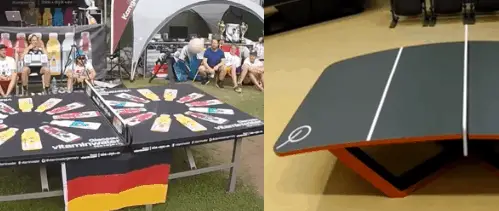At first glance there is a lot in common between Teqball and Headis and in all fairness, the two sports are similar at their core. However, there are many glaring differences between the two sports and in this piece below we strive to explain what are the differences and similarities between Teqball and Headis.
Table of Content
What are the Similarities Between Teqball and Headis?
The most basic similarity is Teqball and Headis are two sports played across a table with a net, with a football-sized ball and without any racket-like equipment (which is bit ironical for a website based on racket sports!).
In essence, both sides, individuals or teams need to use their body parts to send the ball back at their opponent over the net in the centre of a table. As mentioned earlier, there is no use of any rackets in this sport.
What are the Differences Between Teqball and Headis?
While Headis is an extension of table tennis, Teqball was invented by a couple of men who were more interested in football and were forced to use a table to practice their skills on it.
They decided to make things even further exciting by changing the dimensions of the table, making it a fascinating sport not just for the casual follower but also footballers who use the Teqball tables for improving on their football skills.
Invention
Both are relatively younger sports, with Headis having been invented in 2006 and Teqball having come in 2014. Both sports, incidentally, were invented by people who had interest in football (or soccer for American fans!).
A student, René Wegner, couldn’t use a football pitch in Kaiserslautern in Germany and opted to start playing with rubber balls on a table tennis table using the head.
On the other hand, Teqball was invented by Gábor Borsányi and Viktor Huszár, who were also football enthusiasts, who started playing with a football and realised things could be a lot more fun if the table was curved towards the end.
Also Read:
Table Shape
The biggest visual difference between the two sports is how the tables are made. While the Headis table is not too dissimilar from a ping pong (or table tennis) table, the Teqball table is curved towards its ends. In fact, Teqball advertises itself as “World’s Curved”, indicative of the curved tables.
Number of Opportunities
Also, in Headis, players get one opportunity to head the ball back at the opponent, much like in tennis, badminton and table tennis (or ping pong). Teqball is more played on the lines of volleyball, where each player or team has up to three chances to return the ball back at the opponent(s).
Body Parts Allowed to Return Ball
While Headis players are allowed to use only their heads (hence the name!), Teqball competitors can use any part of their body except their hands and arms.
Interestingly, however, Teqball players aren’t allowed to use the same body part on successive turns; i.e. if while returning you head the ball the first time and want to hit the ball back to your opponent, you cannot head it again but have to use another part of the body.
Also Read:
Table Touch
Headis players can use their hands to jump on to the table to return the ball while Teqball players aren’t allowed that luxury.
Scoring
Both can be played over best-of-three but Teqball is played to 20 points while the first to reach 11 points in Headis wins the game.
Doubles Teams
Interestingly, Teqball allows multi-gender teams; i.e. a man and woman in one team can take on two men or two women in a match making it a unisex sport. Usually, most other sports, including Headis don’t allow that for doubles play.
Ball in Use
In terms of equipment, apart from the table, the ball in use is also different for Headis and Teqball.
Headis uses a special rubber ball weighing 100 grams which has a circumference of about 50 cm. Teqball is played with a football, size five. Size five is the regulation size football/soccer ball used by professionals including in competitive soccer.
Conclusion
As someone who has spoken to fans of both sports, the feeling I get is Teqball is enjoyed by fans of soccer since it tests a lot of their technique and they consider it not just as a standalone sport but an extension of their own game.
On the other hand, Headis is said to be an extension of table tennis/ping pong but interesting to see the invention of this sport happened in Germany because a football/soccer pitch was occupied and there was nowhere else to play.


